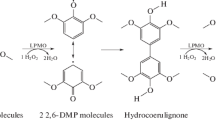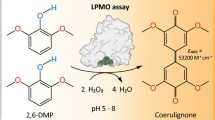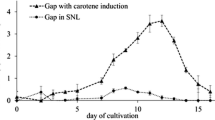Summary
Chloroperoxidase is an extracellular heme glycoprotein produced by the imperfect fungusCaldariomyces fumago. The enzyme can catalyse chlorination reactions as well as act as a catalase or a peroxidase. As a peroxidase, it has a wide substrate specificity and we are interested in some applied aspects of this activity, requiring the production and purification of moderate quantities of the enzyme. High levels of chloroperoxidase are produced in a fructose synthetic medium, and highest enzyme production occurs in a low-shear environment. fungal pellets produce enzyme continuously at low medium replacement rates and at up to 0.6 g enzyme per 1: chloroperoxidase is essentially the only extracellular enzyme produced. Enzyme purification is uncomplicated and gives good yields of high purity. Pure enzyme is stable for weeks at room temperature and under pH control. Chloroperoxidase can be ionically bound to aminopropyl glass, then covalently immobilized by glutaraldehyde crosslinking. Immobilized preparations have been washed and re-used five times, and are most stable at pH 5.5-6. Like many peroxidases, chloroperoxidase will oxidize phenols and phenolics, often causing a precipitate, and can totally remove phenols at low aqueous concentrations. Chloroperoxidase incubation with the petroporphyrin component of crude oil asphaltene (fraction 5) causes a reduction or removal of the Soret band (410 nm) and the α-peak (573 nm). This petroporphyrin fraction is enriched with vanadium which poisons the chemical catalyst used in cracking crude oil.
Similar content being viewed by others
References
Blanke, S.R., S. Yi and L.P. Hager. 1989. Development of semi-continuous and continuous flow bioreactors for the high level production of chloroperoxidase. Biotechnol. Lett. 11: 769–774.
Brotherton, J.E., A. Emery and V.W. Rodwell. 1976. Characterization of sand as a support for immobilized enzymes. Biotechnol. Bioeng. 18: 527–543.
Carmichael, R.D. and M.A. Pickard. 1989. Continuous and batch production of chloroperoxidase by mycelial pellets ofCaldariomyces fumago in an airlift fermentor. Appl. Environ. Microbiol. 55: 17–20.
Carmichael, R.D., P.M. Fedorak and M.A. Pickard. 1985. Oxidation of phenols by chloroperoxidase. Biotechnol. Lett. 7: 289–294.
Carmichael, R.D., A. Jones and M.A. Pickard. 1986. Semicontinous and continuous production of chloroperoxidase byCaldariomyces fumago immobilized in k-carrageenan. Appl. Environ. Microbiol. 51: 276–280.
Fang, G.H., P. Kenigsberg, M.J. Axley, M. Nuell and L.P. Hager. 1986. Cloning and sequencing of chloroperoxidase cDNA. Nucl. Acids Res. 14: 8061–8071.
Feissinger, F., S.W. Malony, J. Manem and J. Mallevialle. 1984. Potential use of enzymes as catalysts in drinking water for the oxidation of taste-causing substances. Aqua 2: 116–118.
Frein, E.M., B.S. Montenecourt and D.E. Eveleigh. 1982. Cellulase production byTrichoderma viride immobilized on k-carrageenan. Biotechnol. Lett. 4: 287–292.
Gonzalez-Vergara, E., D.C. Ales and H.M. Goff. 1985. A simple, rapid, high yield isolation and purification procedure for chloroperoxidase isoenzymes. Prep. Biochem. 15: 335–348.
Hashimoto, A. and M.A. Pickard. 1984. Chloroperoxidase fromCaldariomyces (=Leptoxyphium) cultures: glycoproteins with variable carbohydrate content and isoenzymic forms. J. Gen. Microbiol. 130: 2051–2058.
Hollenberg, P.E. and L.P. Hager. 1970. Purification of chloroperoxidase fromCaldariomyces fumago. Methods Enzymol. 52: 521–529.
Jones, A., D. Berk, B.H. Lesser, L.A. Behie and G.M. Gaucher 1983. Continuous production of patulin by immobilized cells ofPenicillium urticae in a stirred-tank reactor. Biotechnol. Lett. 5: 785–790.
Kadima, T.A. and M.A. Pickard. 1990. A colorimetric assay for chloroperoxidase. Can. J. Microbiol. 36: 302–304.
Kadima, T.A. and M.A. Pickard. 1990. Immobilization of chloroperoxidase on aminopropyl-glass. Appl. Environ. Microbiol. 56: 3473–3477.
Kennedy, J.F. and J.M.S. Cabral. 1983. Immobilized enzymes. In: Solid Phase Biochemistry (W.H. Scouten, ed.), John Wiley and Sons, New York, NY, pp. 253–339.
Kennedy, J.F., and J.M.S. Cabral. 1987. Enzyme immobilization. In: Enzyme Technology (J.F. Kennedy, ed.), VCH Publishers, New York, NY, pp. 347–404.
Klibanov, A.M. and E.D. Morris. 1981. Horseradish peroxidase for the removal of carcinogenic aromatic amines from water. Enzyme Microb. Technol. 3: 119–122.
Klibanov, A.M., T.M. Tu and K.P. Scott. 1983. Peroxidasecatalyzed removal of phenols from coal-conversion waste-waters. Science 221: 259–261.
Manthey, J.A., L.P. Hager and K.D. McElvany. 1984. Protein bromination by bromoperoxidase fromPenicillus capitatus. Methods Enzymol. 107: 439–445.
Martyn, R.P., S.C. Branzei and G.T. Sperl. 1981. Antimicrobial chlorinated b-diketones. Bios. 52: 8–12.
Morris, D.R. and L.P. Hager. 1966. Chloroperoxidase I. Isolation and properties of the crystalline glycoprotein. J. Biol. Chem. 241: 1763–1768.
Neidleman, S.L. and J. Geigert. 1986. Biohalogenation: principles, basic roles and applications. Ellis Horwood Limited, John Wiley and Sons, New York, NY.
Nuell, M.J., G.-H. Fang, M.J. Axley, P. Kenigsberg and L.P. Hager. 1988. Isolation and nucleotide sequence of the chloroperoxidase gene fromCaldariomyes fumago. J. Bacteriol. 170: 1007–1011.
Paice, M.G. and L. Jurasek. 1984. Peroxidase-catalyzed color removal from bleach plant effluent. Biotechnol. Bioeng. 26: 477–480.
Peitersen, N. 1977. Continuous cultivation ofTrichoderma viride on cellulose. Biotechnol. Bioeng. 19: 337–348.
Pickard, M.A. 1981. A defined medium for the production of chloroperoxidase byCaldariomyes fumago Can. J. Microbiol. 27: 1298–1305.
Pickard, M.A. and A. Hashimoto. 1988. Stability and carbohydrate composition of chloroperoxidase fromCaldariomyces fumago grown in a fructose-salt medium. Can. J. Microbiol. 34: 998–1002.
Small, N., J.L. Woodhead and A.D.B. Malcolm. 1984. The properties of immobilized horseradish peroxidase. Biochem. Soc. Trans. 12: 280.
Thomas, J.A., D.R. Morris and L.P. Hager. 1970. Chloroperoxidase VII. Classical peroxidatic, catalatic, and halogenating forms of the enzyme. J. Biol. Chem. 245: 3129–3134.
Weetall, H.H. 1976. Covalent coupling methods for inorganic support materials. Methods Enzymol. 44: 134–148.
Author information
Authors and Affiliations
Rights and permissions
About this article
Cite this article
Pickard, M.A., Kadima, T.A. & Carmichael, R.D. Chloroperoxidase, a peroxidase with potential. Journal of Industrial Microbiology 7, 235–241 (1991). https://doi.org/10.1007/BF01577650
Received:
Revised:
Accepted:
Issue Date:
DOI: https://doi.org/10.1007/BF01577650




